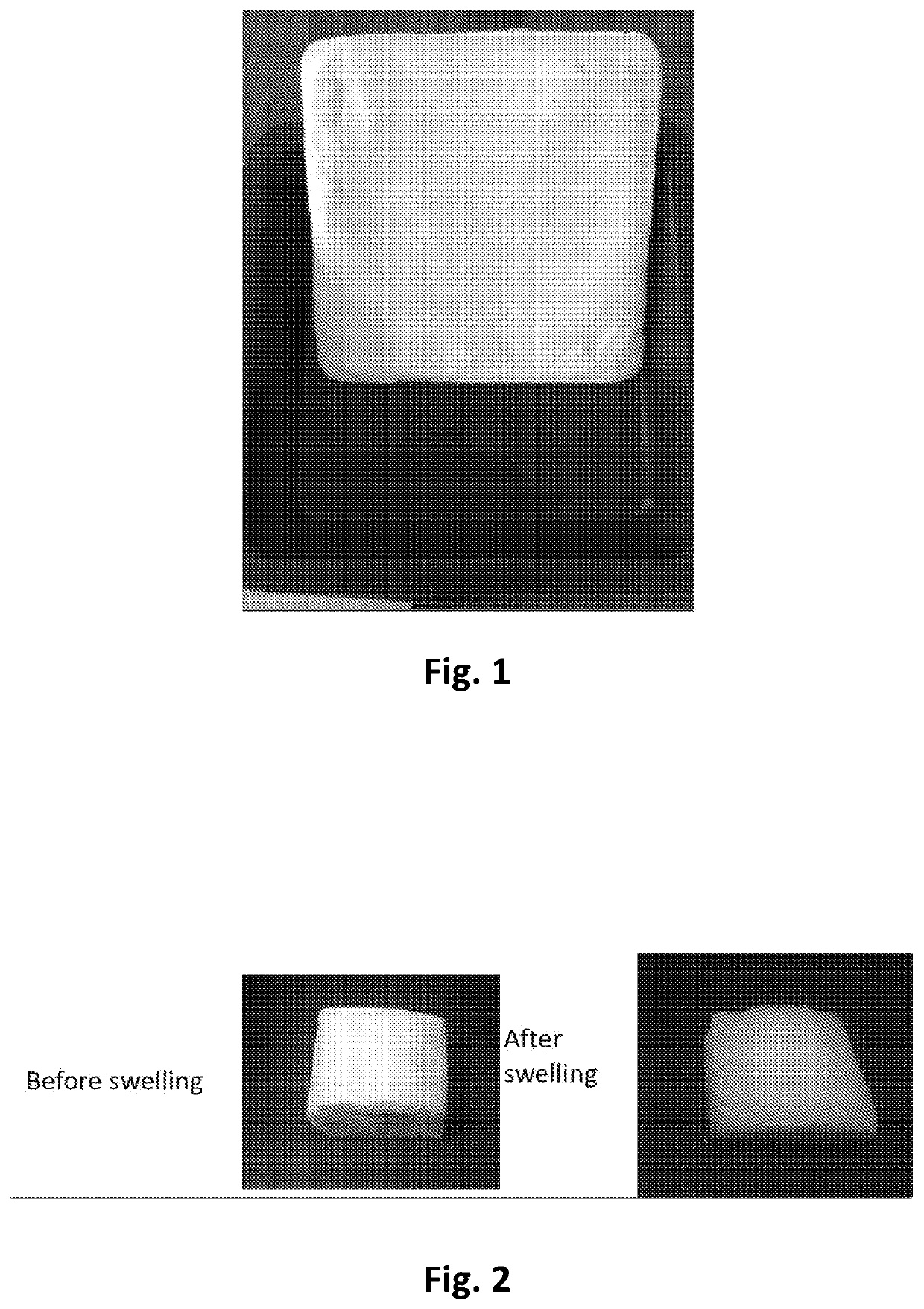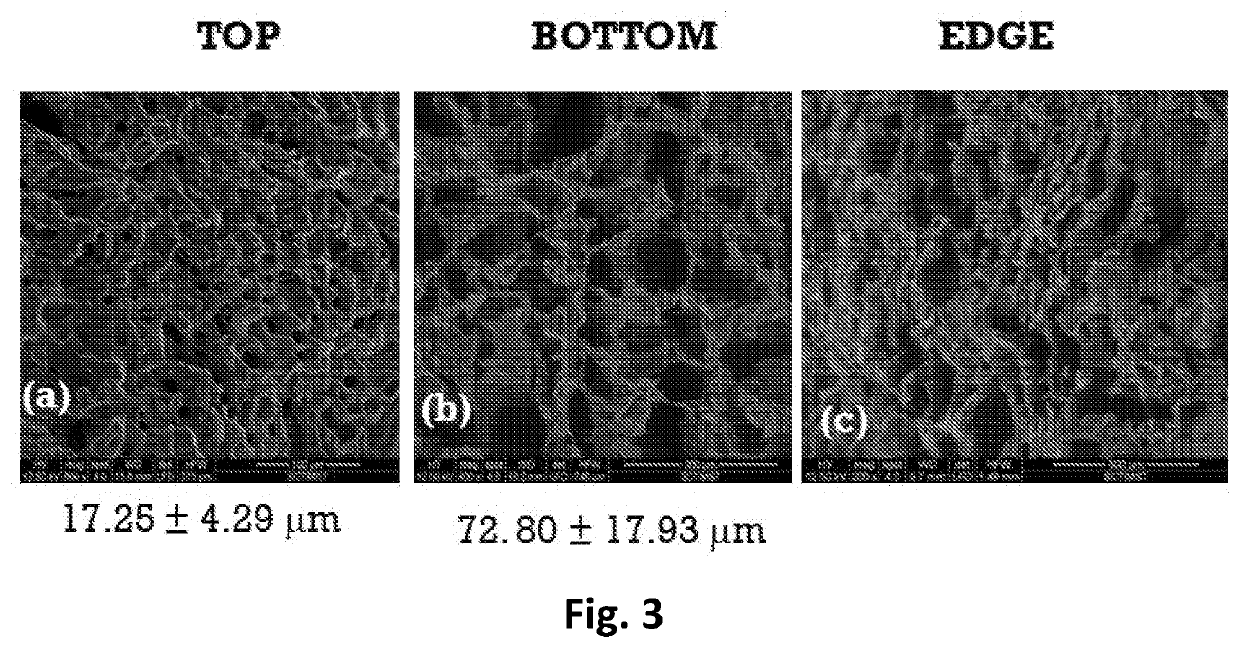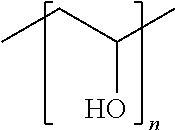Lint Free Crosslinked Chitosan-PVA Sponge as an Absorbent Wound Dressing and Method of Preparation Thereof
- Summary
- Abstract
- Description
- Claims
- Application Information
AI Technical Summary
Benefits of technology
Problems solved by technology
Method used
Image
Examples
example
Example 1: Chitosan-PVA Sponge Using Borate Crosslinking
[0056]2.5% PVA solution is prepared in distilled water heating at 80° C., under magnetic stirring for 3 h. 2% Chitosan is prepared in 0.75% acetic acid aqueous solution under mechanical stirring for 3 h. Chitosan and PVA solutions are mixed in the ratio of 2:1 via mechanical stirring for an hour. 3% borax solution and 0.75% glycerol added to the solution, stirring continued 30 minutes. Final solution is subjected to freezing at −30° C. for 8.3 hours, followed by primary drying with the temperature ramping at a rate of 4° C. / min up to 40° C. The final drying is at 40° C. for 5 minutes. 1 cm×1 cm samples were cut from the dressing and Weight of the sample noted down. Thickness of the sample measured. Density was calculated as follows,
Density (g / cm3)=weight / width×length×thickness
[0057]Density was measured with 5 samples at least. The density if the sample is 0.06±0.012 g / cm3
example 2
nt of the Fluid Absorption Capacity
[0058]The fluid absorption capacity (FAC) and moisture vapor transmission rate (MVTR) of the wound dressing was evaluated using simulated wound fluid as per British Pharmacopoeia standards. For determining the fluid absorbing capacity, dressing of size 1 cm×1 cm and known weight were placed into beakers of the test solution. The dressing samples were removed from the solution at interval of 24 hour and gently blotted to remove excess liquid from the outer surface and then reweighed. The Fluid absorption of the dressing samples was calculated by the following equation:
Absorption rate=Ws−Wd g / cm / day
Fluidabsorptioncapacity(%)=(Ws-Wd)Wd×100
[0059]where Wd and Ws represent the weight of the dressing samples in dry and swollen states.
[0060]The fluid absorption rate of the dressing is 0.63±0.13 g / cm2 / day and Fluid absorption capacity (%) is 2881±581%
example 3
nt of Moisture Vapor Transmission Rate (MVTR)
[0061]The Moisture Vapor Transmission Rate (MVTR) of the dressings was determined as per the standard test method (ASTM E96). The samples were cut in a circular shape with a diameter of 3 mm greater than the diameter of the bottle. The sample thus cut is used as a cap on the mouth of the plastic bottle. The samples were sealed to bottle using a suitable adhesive agent. The setup is weighed and kept at 37° C. in an incubator for 24 hours. The loss in weight because of passage of moisture vapor through the membrane was determined by the difference. The MVTR (g / m2 / h) was calculated by the following equation:
MVTR=Change in mass of the vials with the sample / Area×24 h
[0062]The fluid handling capacity (FHC; g / 10 cm2) of the dressing samples was calculated as the sum of the weight of the test solution retained by the dressing samples (Fluid absorption) and the weight of the fluid lost by vapor transmission through the dressing (MVTR).
[0063]The mo...
PUM
| Property | Measurement | Unit |
|---|---|---|
| Temperature | aaaaa | aaaaa |
| Temperature | aaaaa | aaaaa |
| Temperature | aaaaa | aaaaa |
Abstract
Description
Claims
Application Information
 Login to View More
Login to View More - R&D
- Intellectual Property
- Life Sciences
- Materials
- Tech Scout
- Unparalleled Data Quality
- Higher Quality Content
- 60% Fewer Hallucinations
Browse by: Latest US Patents, China's latest patents, Technical Efficacy Thesaurus, Application Domain, Technology Topic, Popular Technical Reports.
© 2025 PatSnap. All rights reserved.Legal|Privacy policy|Modern Slavery Act Transparency Statement|Sitemap|About US| Contact US: help@patsnap.com



